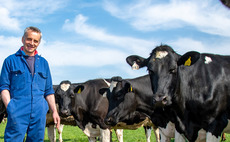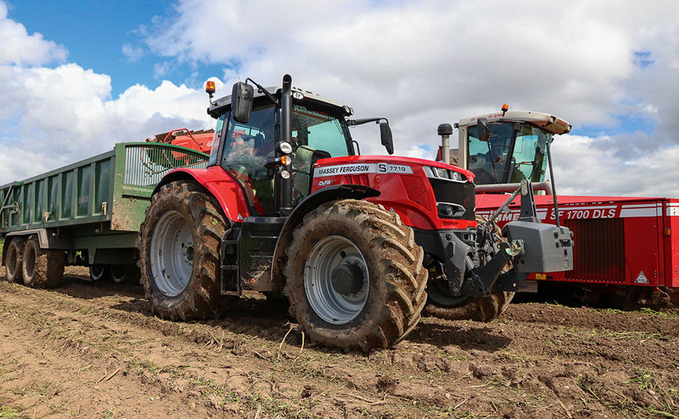
Bolstering its short wheelbase 7700S tractor series with a new model, Alex Heath tries out Massey Ferguson's new machine, and the firm's latest in-cab technology.
Following its launch at the French SIMA machinery show earlier this year, Massey Ferguson's short wheelbase 7700S Series now boasts Stage 5 engines and the firm's new Datatronic 5 terminal.
The options list has also been extended, now offering 42-inch rims on the rear, but the big news is that the range also features a new model, showcased at the Parisian show in the form of the 7719S.
The 7719 moniker was last attributed to a tractor from the MF stable three years ago, albeit in long wheelbase guise.
To see what the new model is capable of and test out the latest terminal technology, we put it to the test with a range of tasks it may face as a prime mover on many mixed farms.
This included road work hauling straw and potatoes, as well as cultivating and drilling, giving us an idea as to what potential customers can expect both from its extra brawn and new brain.
ENGINE
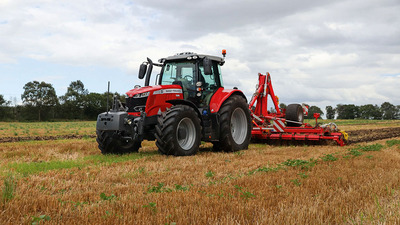
THE latest Stage 5 engine found in the 7719S is a 6.6-litre, six-cylinder block, made in-house by Agco.
Generating maximum power of 190hp at rated speed, it features a useful 30hp boost when called upon by the hydraulic, pto or transmission at certain transport speeds.
Boost starts to kick in at speeds above 6kph, with full power for transport available at 18kph. Hydraulic and pto boost needs load and movement - no minimum speed limit.
Overall, the engine is a strong performer. Pulling a six-metre set of discs at 100mm deep makes it work for its money, as does hauling 20 tonnes of straw.
However, it is composed and surprisingly quiet.
Boost
Reaching our target speed of 12kph with the discs working some gnarly stubble was an ask for the tractor, with only a small amount of boost available. But this was achieved at about 1,500rpm.
Setting a target ground speed, rather than engine speed, allowed the engine to throttle back when this was achieved, saving fuel.
Low down torque is impressive too, with the manufacturer quoting a maximum figure of 980Nm.
Under the bonnet, access to the main fluid filters, level checks and air filters is good, as is the space between the cooling packs. The air filter is particularly accessible, placed right in front of the radiators.
Service intervals on the 7719S are 600 hours. This is in part due to the inclusion of hydraulic tappets which use oil and springs to maintain zero clearance on the valves.
Compared to conventional solid valve lifters which require regular adjusting to maintain a small clearance between the valve and its cam, the engines require less maintenance, burn cleaner and run smoother, says the manufacturer.
TERMINAL AND CONTROLS
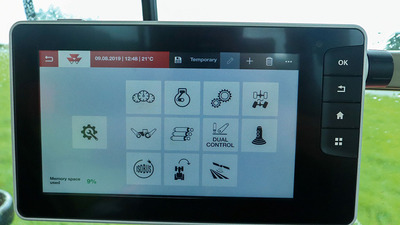
THE crowning glory of the tractor is its new Datatronic 5 terminal.
Through this touch-screen console the whole tractor can be set up, reconfigured and controlled.
The nine-inch screen hangs off a bar in the right-hand doorway. This does make it harder to prod at when on the move, and is limited in the angles it will turn - not ideal when trying to avoid sunlight.
But what a departure it is from the screens of old.
The hardware is the same that Valtra's SmartTouch uses, a screen we very much admire.
For differentiation, the software and user interface is Massey designed. But, it is equally as accessible and intuitive to use as the Finnish version, albeit without the frivolities of fancy spinning graphics.
Its main menu presents a grid with all the usual options, including engine, transmission, hydraulics, GPS and so on.
Alternatively, on the main screen, swiping to the side brings an individual adjustment screen across on a carousel. There is also the option to split the screen if a view of GPS and tractor set-up is needed, for example.
Speaking of GPS, Novotel or Trimble receivers can be run through the screen, with sub-metre to cm accuracies.
Compared to often complex, and at times frustrating processes normally associated with setting up headland management sequences on all makes, MFs is now simplified and straightforward with this interface, and allows for quick setup.
But while the screen is logical to use, some of the controls for the rest of the tractor are needlessly complicated.
Take the rear hitch for example. Anyone not familiar with the ritual which takes place before the hitch reaches 100 per cent could be left scratching their head for an inordinate length of time.
However, we do appreciate the safety element to Massey's methods, and the fact it prevents lift rod wear.
CAB
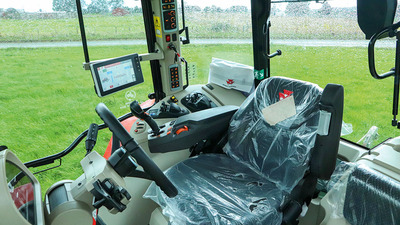
THE cab is reasonably quiet, with decent visibility, and not a bad place to reside for the day.
The six-post design with curved rear quarter windows still offers unparalleled views over the rear mud guards, ideal when pulling any implement wider than three metres.
Controls are neatly grouped on the armrest, right-hand wheel arch and the B-pillar on the same side.
The main bugbear with the cab is its lack of storage, or even flat surfaces for that matter.
The cab has one large box on the left-hand side, and a small cubby hole above the driver's head on the right - and that is it.
The space in the roof is large enough to store a litre bottle, with air conditioning ducts running past it keeping it cool.
But make sure the bottle is strapped in, or it can roll out and land on your head.
Cup holders are also at a premium. A total of two are both located on the lid of the left hand box. However, they are only big enough to hold a drink can, while big bottles roll around the floor.
With space aplenty by the handbrake lever, it would be better if there was a holder for a larger bottle down there. MF does, however, provide straps to help with this.
On the flip side, access to the cab is exemplary. Deep, well proportioned steps are recessed into the 305l fuel tank. At the side of these is a plastic moulded toolbox.
By no means massive, it is bigger than most on tractors these days. It is also removable. Handy.
TRANSMISSION
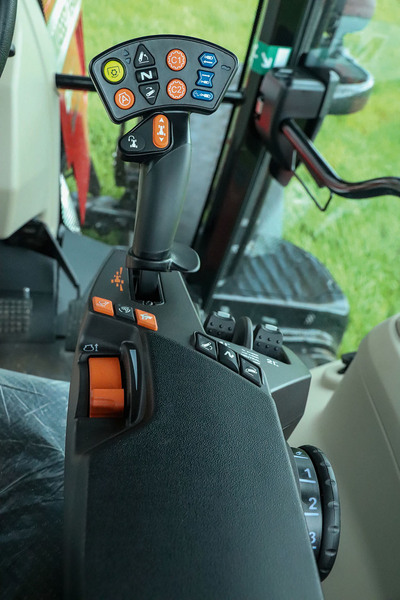
TRANSMISSION choice for the 7719S is limited to the manufacturer's DynaVT continuously variable transmission (CVT).
Also used in the firm's sister company Fendt, it is split into two ranges and offers seamless speed adjustment.
It is important to remember to drop down the range when doing any heavy work in the field, be it cultivations or carting spuds, as we found.
The only problem with this is the tractor needs to be at a standstill when changing up or down the range, perhaps a problem if field conditions are sticky and you do not want to stop and lose momentum.
Lever
Target speeds for the transmission are found on two dials on the righthand side of the cab. These are then selected by pressing the C1 and C2 buttons on the MultiPad transmission control lever.
We have always liked the way the transmission is controlled via a return to centre-style lever, with its simple push forwards to increase speed and pull back to decrease.
Also, when reverse is selected, logically the pulling back of the lever increases speed and vice versa.
Precise speed control both on the road and in yards is achievable, with a good amount of braking given by the stepless box when approaching junctions.
Obviously being a CVT, just standing on the brakes is enough to disengage drive and slow down proceedings, but precise control when reversing, for instance, is harder to achieve.
However, the company has also added a function it calls turbo clutch, which allows for inching, similar to a tractor with a traditional cog box.
Verdict
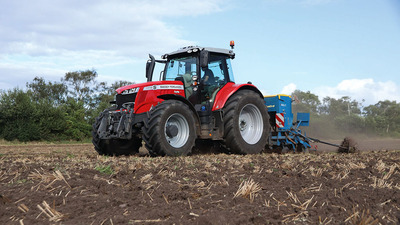
THE tractor is an able performer across a range of tasks.
Its wheelbase is slightly longer than comparative models from other manufacturers in this power range, looking and feeling bigger.
This is no bad thing, as the stability of the tractor is impressive, as is its pulling capability.
This model would be ideal for those looking at a solid tractor for trailer work, that holds its own on the road, but can also be called upon to help with cultivations.
The cab is getting a bit long in the tooth, though, and could do with modernising.
The inclusion of the Datatronic 5 terminal goes some way to simplifying the controls of the machine, but more needs to be done in simplifying some of the switchgear procedures.

















